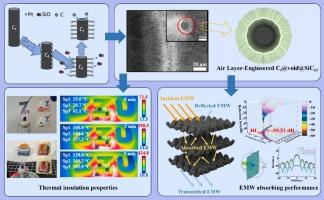Air layer-engineered Cf@void@SiCnf composites for enhanced electromagnetic wave absorption
IF 13.2
1区 工程技术
Q1 ENGINEERING, CHEMICAL
引用次数: 0
Abstract
Conventional carbon-based absorbers often suffer from poor impedance matching and limited loss mechanisms, which hinder their practical effectiveness. In this work, we propose a novel strategy that combines structural engineering with interfacial modulation to construct a hollow-structured composite, denoted as Cf@void@SiCnf. This architecture consists of a Cf core, a tunable air interlayer, and a shell of silicon carbide nanofibers (SiCnf), fabricated through chemical vapor deposition (CVD) followed by controlled oxidation. The introduction of an interfacial air layer between the carbon fiber core and SiC nanofibers significantly improved impedance matching and interfacial polarization. As a result, the composite achieves a minimum reflection loss (RLmin) of −59.21 dB at 6.96 GHz (2.30 mm thickness) and a maximum effective absorption bandwidth (EABmax) of 2.48 GHz at 1.0 mm. Additionally, the air-layer architecture imparts improved thermal insulation, when placed on a 357.3 °C hot surface, the composite's outer surface remains as low as 128.8 °C (after 5 min), indicating its promise for multifunctional thermal management applications. This study highlights the critical role of structural tuning-especially air layer design-in developing impedance-matched, high-performance EMW absorbers.

空气层工程Cf@void@SiCnf复合材料增强电磁波吸收
传统的碳基吸收材料存在阻抗匹配差、损耗机制有限等问题,影响了其实际应用效果。在这项工作中,我们提出了一种将结构工程与界面调制相结合的新策略,以构建空心结构复合材料,表示为Cf@void@SiCnf。该结构由Cf核心、可调谐空气中间层和碳化硅纳米纤维(SiCnf)外壳组成,通过化学气相沉积(CVD)和可控氧化制备。在碳纤维芯和SiC纳米纤维之间引入界面空气层,显著改善了阻抗匹配和界面极化。结果表明,该复合材料在6.96 GHz(厚度2.30 mm)处的最小反射损耗(RLmin)为−59.21 dB,在1.0 mm处的最大有效吸收带宽(EABmax)为2.48 GHz。此外,空气层结构提高了隔热性能,当放置在357.3 °C的热表面上时,复合材料的外表面保持低至128.8 °C(5 分钟后),这表明它有望用于多功能热管理应用。这项研究强调了结构调谐,特别是空气层设计在开发阻抗匹配的高性能EMW吸收器中的关键作用。
本文章由计算机程序翻译,如有差异,请以英文原文为准。
求助全文
约1分钟内获得全文
求助全文
来源期刊

Chemical Engineering Journal
工程技术-工程:化工
CiteScore
21.70
自引率
9.30%
发文量
6781
审稿时长
2.4 months
期刊介绍:
The Chemical Engineering Journal is an international research journal that invites contributions of original and novel fundamental research. It aims to provide an international platform for presenting original fundamental research, interpretative reviews, and discussions on new developments in chemical engineering. The journal welcomes papers that describe novel theory and its practical application, as well as those that demonstrate the transfer of techniques from other disciplines. It also welcomes reports on carefully conducted experimental work that is soundly interpreted. The main focus of the journal is on original and rigorous research results that have broad significance. The Catalysis section within the Chemical Engineering Journal focuses specifically on Experimental and Theoretical studies in the fields of heterogeneous catalysis, molecular catalysis, and biocatalysis. These studies have industrial impact on various sectors such as chemicals, energy, materials, foods, healthcare, and environmental protection.
 求助内容:
求助内容: 应助结果提醒方式:
应助结果提醒方式:


